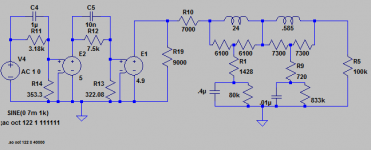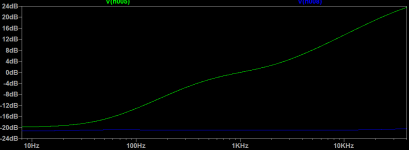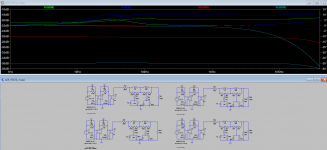Hello fellow DIYers,
I am in the process of building and simulating LCR networks (7k3 LCR and response attached) and wanted to know how you can simulate different source impedance.
Is there something I can do to the voltage element in the inverse RIAA or a R value that is needed?
I want to do this because the LCR will be loaded via a parafeed 6c45p and I want to find the best LCR network load that is not effected by tube aging and a increase in plate resistance because of transcendence change. Want to find the best 4k to 10k LCR that works perfect.
Some schematics I have seem also have different configurations of C and R below the instructors and not sure why they build them that way but I want to try every possibility before I find the right one for me.
Thanks.
I am in the process of building and simulating LCR networks (7k3 LCR and response attached) and wanted to know how you can simulate different source impedance.
Is there something I can do to the voltage element in the inverse RIAA or a R value that is needed?
I want to do this because the LCR will be loaded via a parafeed 6c45p and I want to find the best LCR network load that is not effected by tube aging and a increase in plate resistance because of transcendence change. Want to find the best 4k to 10k LCR that works perfect.
Some schematics I have seem also have different configurations of C and R below the instructors and not sure why they build them that way but I want to try every possibility before I find the right one for me.
Thanks.
Attachments
You can simulate different source impedance by adding the impedance in series with the output of the last voltage source. Adding an impedance in parallel with the voltage source will do nothing.
Thanks DF96,
I thought it was that easy. I can now sim different values and see how the network behaves with source and loads.
Is there also a way to simulate harmonic distortion in LTSprice or inter-modulate distortion simulations? Or is it limited to freq,transient only.
I thought it was that easy. I can now sim different values and see how the network behaves with source and loads.
Is there also a way to simulate harmonic distortion in LTSprice or inter-modulate distortion simulations? Or is it limited to freq,transient only.
Attachments
linear models don't generate distortion components
so you need nonlinear models to see any harmonic distortion/IMD products
so you need nonlinear models to see any harmonic distortion/IMD products
That would mean I need to figure out the distortion on the C, R, L, wire (ie real world) else it only simulates perfection.
So I need to build them in the real work to really see the major differences between a 600R, 4k, 7k LCR network. when it comes to distortion, IM.
So I need to build them in the real work to really see the major differences between a 600R, 4k, 7k LCR network. when it comes to distortion, IM.
The main source of distortion will be the inductor. That is why most people avoid LCR RIAA.
Could you elaborate a bit more?
What type of distortion is the inductor introducing?
At least the low DCR inductor will introduce less noise than a high value resistor.
I am pretty sure that "most people" don't avoid LCR RIAA because of the distortion; IMO it's not an issue of any importance in the complete phono preamplifier.
Actually I doubt if simulating phono preamps is of much use.
Iron cored inductors are nonlinear. Careful design can minimise this, but it may still be the case that inductor nonlinearity is similar in magnitude to active device nonlinearity. Why choose to use a component which is signficantly non-ideal in its properties? Air-cored inductors will be huge and have significant resistance.
All RIAA circuits will use resistors, so thermal noise cannot be avoided. Choosing the right circuit impedance will reduce it to negligible proportions.
The other problems with LCR networks are:
1. poor inductor value tolerance - unless carefully measured during construction
2. hum pickup
3. significant inductor strays (resistance, capacitance) which may need to be taken account of in the design
Most people avoid LCR RIAA because it has no advantages and significant disadvantages over CR circuits.
The nearest thing to an ideal component we have is a resistor. Most capacitors are not far behind. Inductors are a long way behind, which is why they are only used in good circuits when necessary i.e. when their features outweigh their problems.
All RIAA circuits will use resistors, so thermal noise cannot be avoided. Choosing the right circuit impedance will reduce it to negligible proportions.
The other problems with LCR networks are:
1. poor inductor value tolerance - unless carefully measured during construction
2. hum pickup
3. significant inductor strays (resistance, capacitance) which may need to be taken account of in the design
Most people avoid LCR RIAA because it has no advantages and significant disadvantages over CR circuits.
The nearest thing to an ideal component we have is a resistor. Most capacitors are not far behind. Inductors are a long way behind, which is why they are only used in good circuits when necessary i.e. when their features outweigh their problems.
Most people avoid LCR RIAA because it has no advantages and significant disadvantages over CR circuits.
Who are "most people"?
Obviously CR RIAA works well, also much less expensive.
However, "quite some people" prefer LCR RIAA; they listen with their ears instead of staring at meters and oscilloscopes 😀.
All potential drawbacks you mention can be avoided by good engineering.
But let's not hijack this thread with a CR vs LCR debate 😉
However, "quite some people" prefer LCR RIAA; they listen with their ears instead of staring at meters and oscilloscopes 😀.
OTOH in some/many instances the impairments that Dave mentions are measurable and possibly audible. Many people also prefer SET amps.
To be productive a reference for the OP. http://www.ee.bgu.ac.il/~spice/Additional/non_linear_pres.pdf
Last edited:
OTOH in some/many instances the impairments that Dave mentions are measurable and possibly audible. Many people also prefer SET amps.
Everlasting and senseless discussion Scott....
Everlasting and senseless discussion Scott....
Is it really senseless? I've been there listening along, I don't judge someone's listening preference just at the point where what's going on is obvious folks should just be honest about it.
BTW listening to Sibelius on LP with an LRC pre-amp right now, as good as they have ever sounded.
I think the phrase has a fairly clear meaning, but for the avoidance of doubt I mean 'most people who have an RIAA preamp using analogue techniques will have one using CR networks rather than LCR networks'. I have not personally counted all the world's phono preamps but I think I am correct to make this claim. LCR RIAA is a minority preference.pieter t said:Who are "most people"?
I am not sure what you mean by "quite some people"; I suspect the number is a very small but not entirely insignificant minority. All people listen with their ears, but ears are easily fooled. If you are saying that some people prefer the sound from somewhat flawed circuits to better circuits then I cannot disagree.However, "quite some people" prefer LCR RIAA; they listen with their ears instead of staring at meters and oscilloscopes
I would like to see an inductor design which over the audio range has as near-ideal properties as almost any film cap. Good design can minimise the problems, but as LCR RIAA has no advantage over CR why not avoid the problems altogether by ditching the inductors?All potential drawbacks you mention can be avoided by good engineering.
I agree. I was answering a question, and offering an opinion. I suspect you hold the opposite opinion?But let's not hijack this thread with a CR vs LCR debate
- Status
- Not open for further replies.
- Home
- Source & Line
- Analogue Source
- Simulate LCR RIAA Networks with LTspice


